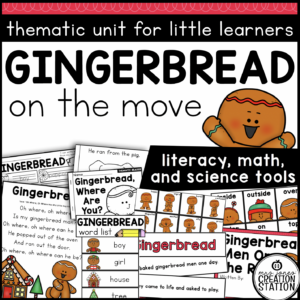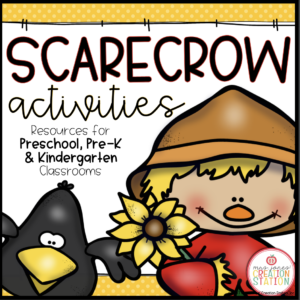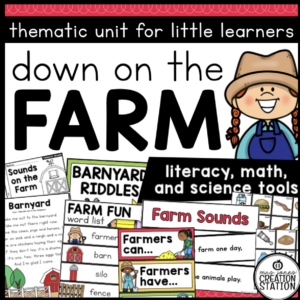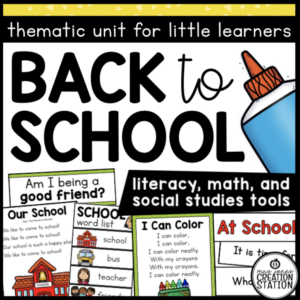PUMPKINS UNIT FOR PRESCHOOL, PREK AND KINDERGARTEN
Bring fall to your classroom with these science based pumpkin activities! Your learners will love investigating pumpkins through hands on activities as well as learn all about the life cycle of pumpkins.
This unit does a great job of joining science and literacy together with shared reading, writing activities as well as my popular interactive poem.
The easy to follow thematic lesson plans provide a daily objective to learn more about pumpkins, how they grow, and what’s inside. A list of fun picture books are included that are easy to find by just using one click!
Buy the BUNDLE and SAVE! You can purchase this resources in the Thematic Activities for Little Learners Bundle and the Little Learners Mega-Bundle!
THIS RESOURCE INCLUDES
Pumpkins Lesson Resources
This is a template for lesson plans during pumpkin week of school. Pick and choose what ideas and resources work for your learners.
These resources can be used during whole group instruction for a pumpkin theme. They include a poem, word cards, tracing page and table sign in sheets.
Use this poem during a thematic lesson, whole group or a literacy center and have learners count the dots of cream.
Pumpkins Lesson Plans
Use these plans as a guide for engaging pumpkin read alouds and activities in the classroom.
Read Pumpkins and complete the Pumpkin chart by adding descriptive words. Learners may add to their All About Pumpkins book.
Read Our Pumpkin and complete the Pumpkin chart by measuring and comparing the different pumpkins in the classroom. Learners may add to their All About Pumpkins book.
Read Pumpkin Trouble and have learners explore what is inside a pumpkin. Learners may add to their All About Pumpkins book.
Read From Seed to Pumpkin and complete the Pumpkin chart by adding the stages of a pumpkin’s growth. Learners may add to their All About Pumpkins book.
Read Stumpkin and have learners decorate their own pumpkin. If Halloween has passed, have a pumpkin tasting party instead.
Explore the pumpkin patch with the five senses. Complete the charts together and have learners draw and write about a patch using their senses on the interactive page.
Pumpkin Predictable Chart Class Book
Use this resource to create a class book from the predictable chart created during the week.
Literacy Centers
Literacy Center | ABC Sort
Have learners sort the letters by capital or lowercase.
Literacy Center | Initial Sound Puzzles
Have learners match the two pictures that begin with each initial sound (/x/ is ending).
Literacy Center | Syllables Write the Room
Have learners find the pictures around the room and color the correct number of syllables.
Math Centers
Math Center | Matching Pumpkins
Have learners matching the pumpkins by their decorations.
Math Center | Number Mats
Have learners explore the numbers using the number mats with ten frames, counting and writing numbers.
Math Center | Number Pocket Chart
Have learners match the puzzles by putting the numbers in the correct order.
LEARNING STANDARDS INCLUDED IN THIS RESOURCE
Common Core Standards
Language Arts
CCSSL.K.1a
Print many upper- and lowercase letters.
CCSSL.K.5c
Identify real-life connections between words and their use (e.g., note places at school that are colorful).
CCSSL.K.6
Use words and phrases acquired through conversations, reading and being read to, and responding to texts.
CCSSRF.K.1d
Recognize and name all upper- and lowercase letters of the alphabet.
CCSSRF.K.2
Demonstrate understanding of spoken words, syllables, and sounds (phonemes).
CCSSRF.K.2b
Count, pronounce, blend, and segment syllables in spoken words.
CCSSRF.K.2d
Isolate and pronounce the initial, medial vowel, and final sounds (phonemes) in three-phoneme (consonant-vowel-consonant, or CVC) words. (This does not include CVCs ending with /l/, /r/, or /x/.)
CCSSRI.K.1
With prompting and support, ask and answer questions about key details in a text.
CCSSRI.K.4
With prompting and support, ask and answer questions about unknown words in a text.
CCSSRI.K.7
With prompting and support, describe the relationship between illustrations and the text in which they appear (e.g., what person, place, thing, or idea in the text an illustration depicts).
CCSSSL.K.5
Add drawings or other visual displays to descriptions as desired to provide additional detail.
CCSSW.K.2
Use a combination of drawing, dictating, and writing to compose informative/explanatory texts in which they name what they are writing about and supply some information about the topic.
Math
CCSSK.CC.A.3
Write numbers from 0 to 20. Represent a number of objects with a written numeral 0-20 (with 0 representing a count of no objects).
CCSSK.CC.B.4
Understand the relationship between numbers and quantities; connect counting to cardinality.
CCSSK.CC.B.4a
When counting objects, say the number names in the standard order, pairing each object with one and only one number name and each number name with one and only one object.
CCSSK.CC.B.4b
Understand that the last number name said tells the number of objects counted. The number of objects is the same regardless of their arrangement or the order in which they were counted.
CCSSK.CC.B.5
Count to answer “how many?” questions about as many as 20 things arranged in a line, a rectangular array, or a circle, or as many as 10 things in a scattered configuration; given a number from 1-20, count out that many objects.
CCSSK.G.B.4
Analyze and compare two- and three-dimensional shapes, in different sizes and orientations, using informal language to describe their similarities, differences, parts (e.g., number of sides and vertices/“corners”) and other attributes (e.g., having sides of equal length).
Next Generation Science Standards
NGSSK-ESS3-1
Use a model to represent the relationship between the needs of different plants or animals (including humans) and the places they live. Examples of relationships could include that deer eat buds and leaves, therefore, they usually live in forested areas; and, grasses need sunlight so they often grow in meadows. Plants, animals, and their surroundings make up a system.
NGSSK-ESS2-2
Construct an argument supported by evidence for how plants and animals (including humans) can change the environment to meet their needs. Examples of plants and animals changing their environment could include a squirrel digs in the ground to hide its food and tree roots can break concrete.
NGSSK-LS1-1
Use observations to describe patterns of what plants and animals (including humans) need to survive. Examples of patterns could include that animals need to take in food but plants do not; the different kinds of food needed by different types of animals; the requirement of plants to have light; and, that all living things need water.
Texas Essential of Knowledge and Skills
Langauge Arts
TEKSLA.K.2.A.ii
Developing and sustaining foundational language skills: listening, speaking, reading, writing, and thinking–beginning reading and writing…The student is expected to: demonstrate phonological awareness by: recognizing spoken alliteration or groups of words that begin with the same spoken onset or initial sound.
TEKSLA.K.2.A.iv
Developing and sustaining foundational language skills: listening, speaking, reading, writing, and thinking–beginning reading and writing…The student is expected to: demonstrate phonological awareness by: identifying syllables in spoken words.
TEKSLA.K.2.A.vi
Developing and sustaining foundational language skills: listening, speaking, reading, writing, and thinking–beginning reading and writing…The student is expected to: demonstrate phonological awareness by: segmenting multisyllabic words into syllables.
TEKSLA.K.2.A.ix
Developing and sustaining foundational language skills: listening, speaking, reading, writing, and thinking–beginning reading and writing…The student is expected to: demonstrate phonological awareness by: manipulating syllables within a multisyllabic word.
TEKSLA.K.2.D.v
Developing and sustaining foundational language skills: listening, speaking, reading, writing, and thinking–beginning reading and writing… The student is expected to: demonstrate print awareness by: identifying all uppercase and lowercase letters.
TEKSLA.K.2.E
Developing and sustaining foundational language skills: listening, speaking, reading, writing, and thinking–beginning reading and writing…The student is expected to: develop handwriting by accurately forming all uppercase and lowercase letters using appropriate directionality.
TEKSLA.K.3.B
Developing and sustaining foundational language skills: listening, speaking, reading, writing, and thinking–vocabulary. The student uses newly acquired vocabulary expressively. The student is expected to: use illustrations and texts the student is able to read or hear to learn or clarify word meanings.
TEKSLA.K.5.C
Comprehension skills: listening, speaking, reading, writing, and thinking using multiple texts. The student uses metacognitive skills to both develop and deepen comprehension of increasingly complex texts. The student is expected to: make and confirm predictions using text features and structures with adult assistance.
TEKSLA.K.5.D
Comprehension skills: listening, speaking, reading, writing, and thinking using multiple texts. The student uses metacognitive skills to both develop and deepen comprehension of increasingly complex texts. The student is expected to: create mental images to deepen understanding with adult assistance.
TEKSLA.K.5.E
Comprehension skills: listening, speaking, reading, writing, and thinking using multiple texts. The student uses metacognitive skills to both develop and deepen comprehension of increasingly complex texts. The student is expected to: make connections to personal experiences, ideas in other texts, and society with adult assistance.
TEKSLA.K.5.H
Comprehension skills: listening, speaking, reading, writing, and thinking using multiple texts. The student uses metacognitive skills to both develop and deepen comprehension of increasingly complex texts. The student is expected to: synthesize information to create new understanding with adult assistance.
TEKSLA.K.6.B
Response skills: listening, speaking, reading, writing, and thinking using multiple texts. The student responds to an increasingly challenging variety of sources that are read, heard, or viewed. The student is expected to: provide an oral, pictorial, or written response to a text.
TEKSLA.K.6.F
Response skills: listening, speaking, reading, writing, and thinking using multiple texts. The student responds to an increasingly challenging variety of sources that are read, heard, or viewed. The student is expected to: respond using newly acquired vocabulary as appropriate.
Math
TEKSMA.K.2.A
Number and operations. The student applies mathematical process standards to understand how to represent and compare whole numbers, the relative position and magnitude of whole numbers, and relationships within the numeration system. The student is expected to: count forward and backward to at least 20 with and without objects.
TEKSMA.K.2.B
Number and operations. The student applies mathematical process standards to understand how to represent and compare whole numbers, the relative position and magnitude of whole numbers, and relationships within the numeration system. The student is expected to: read, write, and represent whole numbers from 0 to at least 20 with and without objects or pictures.
TEKSMA.K.2.C
Number and operations. The student applies mathematical process standards to understand how to represent and compare whole numbers, the relative position and magnitude of whole numbers, and relationships within the numeration system. The student is expected to: count a set of objects up to at least 20 and demonstrate that the last number said tells the number of objects in the set regardless of their arrangement or order.
TEKSMA.K.2.D
Number and operations. The student applies mathematical process standards to understand how to represent and compare whole numbers, the relative position and magnitude of whole numbers, and relationships within the numeration system. The student is expected to: recognize instantly the quantity of a small group of objects in organized and random arrangements.
TEKSMA.K.6.D
Geometry and measurement. The student applies mathematical process standards to analyze attributes of two-dimensional shapes and three-dimensional solids to develop generalizations about their properties. The student is expected to: identify attributes of two-dimensional shapes using informal and formal geometric language interchangeably.
Science
TEKSSCI.K.2.B
Scientific investigation and reasoning. The student develops abilities to ask questions and seek answers in classroom and outdoor investigations. The student is expected to: plan and conduct simple descriptive investigations.
TEKSSCI.K.2.C
Scientific investigation and reasoning. The student develops abilities to ask questions and seek answers in classroom and outdoor investigations. The student is expected to: collect data and make observations using simple tools.
TEKSSCI.K.2.D
Scientific investigation and reasoning. The student develops abilities to ask questions and seek answers in classroom and outdoor investigations. The student is expected to: record and organize data and observations using pictures, numbers, and words.
TEKSSCI.K.2.E
Scientific investigation and reasoning. The student develops abilities to ask questions and seek answers in classroom and outdoor investigations. The student is expected to: communicate observations about simple descriptive investigations.
TEKSSCI.K.4.B
Scientific investigation and reasoning. The student uses age-appropriate tools and models to investigate the natural world. The student is expected to: use the senses as a tool of observation to identify properties and patterns of organisms, objects, and events in the environment.
TEKSSCI.K.5.A
Matter and energy. The student knows that objects have properties and patterns. The student is expected to: observe and record properties of objects, including bigger or smaller, heavier or lighter, shape, color, and texture.
CONNECT WITH MJCS
WEBSITE | FACEBOOK | INSTAGRAM | PINTEREST
SaveSave




